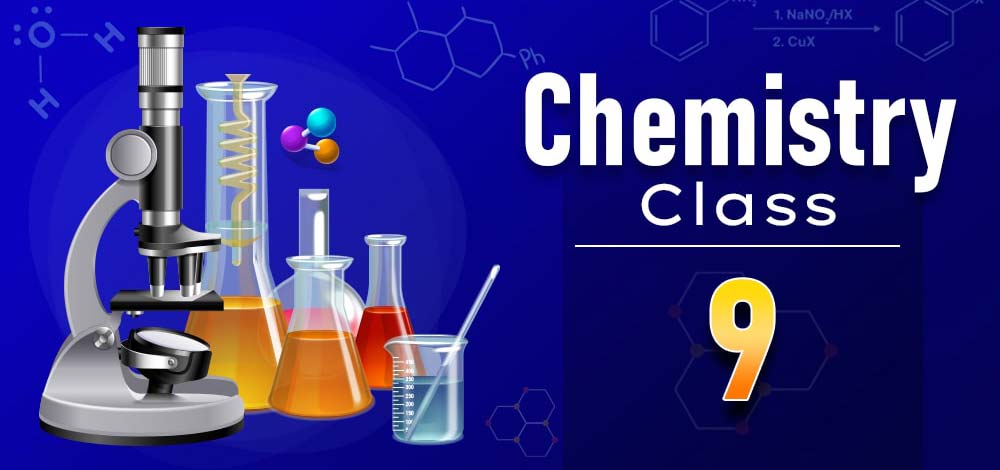CBSE Class 9 Chemistry Notes
Last Updated :
18 Mar, 2023
Chemistry is a branch of science that studies the structure of substances and what happens to them in different conditions or when mixed with each other. The fundamental elements of Matter, Atoms, and Molecules are the main focus of Class 9 Chemistry Notes. These Chemistry notes will help not even to gain good grades in your exams but also help for the preparation of competitive exams like KVPY, NTSE, Olympiads, etc. Thus, GeeksforGeeks’s Class 9 Chemistry notes are designed and developed per the NCERT textbook of Science for Class 9, in such a way that will help students to study more efficiently and understand each concept covered in their Class 9 syllabus.
GeeksforGeeks presented Free Chapterwise CBSE Notes for revision, to learn and explore more about the subject. The below-mentioned articles in each Chapter consist of all the important topics that are needed to study for scoring good marks and knowledge. These Class 9 Chemistry Notes have been designed based on the latest NCERT books and curriculum issued for this academic session.

Chapter 1: Matter in our Surroundings
Chapter 1 in the Class 9 Chemistry curriculum is “Matter in our Surroundings”. In this chapter, we will study things or matters that exist around us. Everything in the universe is made up of substances that scientists refer to as matter. Hence, Everything around us is matters: the food we eat, the water we drink, the air we breathe, plants and animals, etc. Following are a list of the major topics that are discussed in the articles along with some solved Sample Questions to understand better:
Chapter 2: Is Matter Around Us Pure
The second chapter in the Class 9 syllabus is in the continuation of the previous Chapter. Is Matter Around Us Pure, helps to understand that the matter, what we discussed in the previous chapter is pure or not. In our day-to-day life, we come across and utilize a variety of items on a regular basis, such as milk, butter, salt, water, and juice. What factors do we use to determine whether or not all of these things are pure? So, the following articles provided in the below links helps to learn more about the matter and its properties:
Chapter 3: Atoms and Molecules
Chapter 3 in the Class 9 Chemistry syllabus is Atoms and Molecules. Atom is the smallest building block that constitutes a matter. However, a molecule is a group of two or more atoms combined together. Atoms and molecules are a significant part of a chemical reaction. The laws of chemical combination are the first major idea covered in this chapter. Under this Chapter, the following topics are explained in the links mentioned below:
Chapter 4: Structure of the Atom
Structure of Atom is the last and the fourth chapter in the Class 9 Chemistry curriculum. Structure of the Atom introduces the concept of how atoms were discovered, as well as other historical aspects of the atom’s discovery. These notes give students a review of the chapter, crucial things to remember, and extensive explanations of key concepts and derivations to help them comprehend the material better. Class 9 Notes on the Structure of the Atom is designed to make learning and revision easier through the following articles:
- What is an Atom? Definition, Structure, Parts
- Composition of an Atom
- Charged Particles in Matter
- Discovery of Electrons
- What is a Proton? Definition, Discovery, Characteristics
- Neutron – Discovery, Definition, Characteristics, Applications
- Thomson’s Atomic Model
- Rutherford’s Alpha Scattering Experiment
- Atomic Nucleus – Definition, Structure, Discovery, Characteristics
- Rutherford’s Atomic Model
- Drawbacks of Rutherford’s Atomic Model
- How did Neil Bohr explained the Stability of Atom?
- Bohr’s Model of an Atom
- Atomic Number and Mass Number
- Relation Between Mass Number and Atomic Number
- Arrangement of Electrons in the Atoms
- Electronic Configuration of Elements
- Potassium and Calcium – Atomic Structure, Chemical Properties, Uses
- Valence Electrons
- Noble Gas
- What is meant by Chemical Combination?
- Valency and Valence Electrons: Definition, Examples, and Relation
- Difference between Electrovalency and Covalency
- What are Isotopes?
- Why do all the Isotopes of an Element have similar Chemical Properties?
- Why Isotopes have different Physical Properties?
- What is Fractional Atomic Mass?
- Radioactive Isotopes – Definition, Properties, Uses
- What are Isotopes?
Share your thoughts in the comments
Please Login to comment...